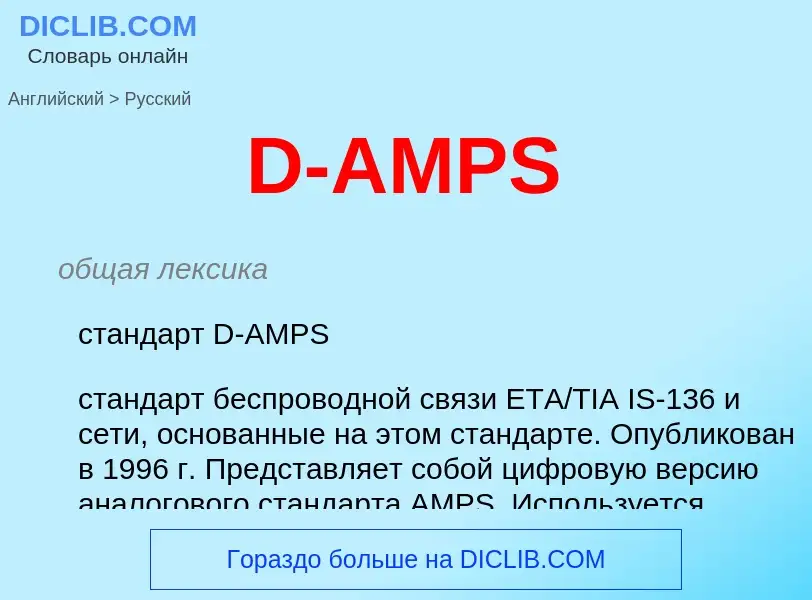Translation and analysis of words by ChatGPT artificial intelligence
On this page you can get a detailed analysis of a word or phrase, produced by the best artificial intelligence technology to date:
- how the word is used
- frequency of use
- it is used more often in oral or written speech
- word translation options
- usage examples (several phrases with translation)
- etymology
D-AMPS - translation to English
общая лексика
стандарт D-AMPS
стандарт беспроводной связи ETA/TIA IS-136 и сети, основанные на этом стандарте. Опубликован в 1996 г. Представляет собой цифровую версию аналогового стандарта AMPS. Используется диапазон частот 824-840 МГц для обратного канала (мобильный терминал - базовая станция) и 869-894 МГц для прямого канала. В частотном диапазоне размещается 533 канала связи
Смотрите также
Definition
Wikipedia
IS-54 and IS-136 are second-generation (2G) mobile phone systems, known as Digital AMPS (D-AMPS), and a further development of the North American 1G mobile system Advanced Mobile Phone System (AMPS). It was once prevalent throughout the Americas, particularly in the United States and Canada since the first commercial network was deployed in 1993. D-AMPS is considered end-of-life, and existing networks have mostly been replaced by GSM/GPRS or CDMA2000 technologies.
This system is most often referred to as TDMA. That name is based on the abbreviation for time-division multiple access, a common multiple access technique which is used in most 2G standards, including GSM, as well as in IS-54 and IS-136. D-AMPS competed against GSM and systems based on code-division multiple access (CDMA).
D-AMPS uses existing AMPS channels and allows for smooth transition between digital and analog systems in the same area. Capacity was increased over the preceding analog design by dividing each 30 kHz channel pair into three time slots (hence time division) and digitally compressing the voice data, yielding three times the call capacity in a single cell. A digital system also made calls more secure in the beginning, as analogue scanners could not access digital signals. Calls were encrypted, using CMEA, which was later found to be weak.
IS-136 added a number of features to the original IS-54 specification, including text messaging, circuit switched data (CSD), and an improved compression protocol. SMS and CSD were both available as part of the GSM protocol, and IS-136 implemented them in a nearly identical fashion.
Former large IS-136 networks, including AT&T in the United States, and Rogers Wireless in Canada, have upgraded their existing IS-136 networks to GSM/GPRS. Rogers Wireless removed all 1900 MHz IS-136 in 2003, and has done the same with its 800 MHz spectrum as the equipment failed. Rogers deactivated its IS-136 network (along with AMPS) on May 31, 2007. AT&T soon followed in February 2008, shutting down both TDMA and AMPS.
Alltel, who primarily used CDMA2000 technology but acquired a TDMA network from Western Wireless, shut down its TDMA and AMPS networks in September 2008. US Cellular, which now also primarily uses CDMA2000 technology, shut down its TDMA network in February 2009.
IS-54 is the first mobile communication system which had provision for security, and the first to employ TDMA technology.

